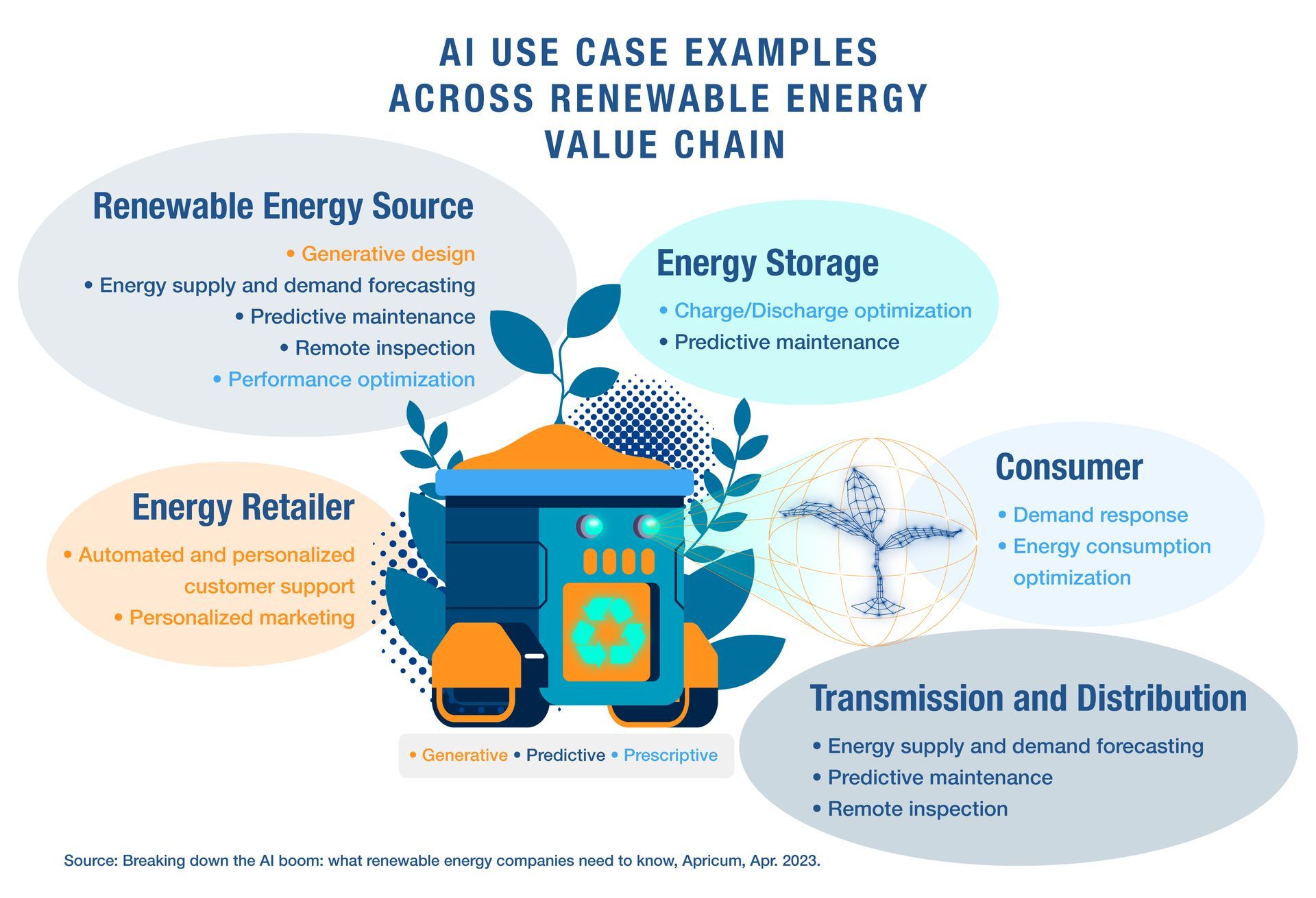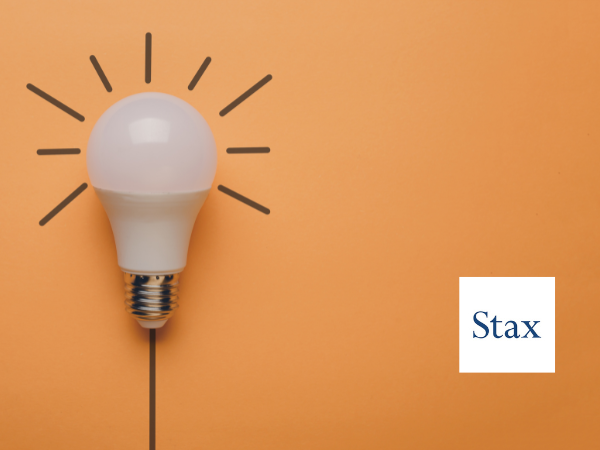Share
Market Overview
The renewable energy sector is undergoing a significant transformation propelled by the rapid
integration of Artificial Intelligence (AI), revolutionizing the entire renewable energy value chain—from resource assessment to energy generation, storage, and distribution. AI is expected to significantly boost efficiency, optimize operations, and streamline decision making.
Market estimates indicate the global AI in renewable energy market at a valuation of $600M in 2022, with expectations to reach approximately $4.6B by 2032, growing at a healthy CAGR of approximately 23.2% over the forecast period (2023-2032).
Use Cases

Optimizing Renewable Energy Generation and Storage
AI has the potential to enhance a grid’s stability and assess the balance between renewable energy generation and demand, while also facilitating intelligent charging for electric vehicles and batteries. As the process of smart charging is now optimized, it contributes towards a more sustainable and efficient energy ecosystem.
Renewable Energy Forecasting
In the forecasting of renewable energy output, AI can analyze weather forecasts, historical data, and current conditions. This approach enables energy providers with the necessary insights to effectively position supply and demand—especially for variable sources like wind and solar.
Reducing Solar Power Curtailment Costs
To minimize losses in solar energy production caused by grid limitations (solar power curtailment), AI analyzes grid conditions, weather forecasts, and demand variations. Utilizing AI in this scenario optimizes the generation and distribution of solar power, aligning with grid capacity. The result is minimized curtailment and maximized revenue for operators in the renewable energy sector.
Predictive Maintenance
AI and machine learning can drive predictive maintenance systems to analyze vast datasets from various sources, including sensors. These algorithms detect patterns that may indicate potential issues. By continuously monitoring and analyzing equipment data, AI identifies anomalies, serving as indicators for necessary mitigation, maintenance, or repairs.
Demand Response
Provides recommendations to energy consumers on optimizing their consumption patterns, advising on when to increase or decrease usage to align with energy production volumes and consequently decrease the overall system costs.
Case Studies
PowerScout
A California-based renewable energy firm, PowerScout, uses AI and machine learning to optimize operations. The AI platform analyzes data from over 100 billion data points, covering 45 million households, to predict which homes are likely to adopt solar energy. This helps solar installers focus their marketing efforts on the most promising prospects, increasing the chances of generating revenue.
E.ON
The German company E.ON is a leader in utilizing AI to manage fluctuations in renewable energy production. Using AI, E.ON predicts anticipated wind levels at specific wind farm locations for the next day, allowing them to preemptively respond to energy balance fluctuations. Additionally, E.ON employs AI technologies to improve energy distribution and storage, optimizing the balance between local energy generation and consumption. The company also utilizes AI to enhance energy yield in wind farms, orchestrating the synchronization of turbines for optimal alignment with prevailing wind conditions.
AI's Role in Advancing Renewable Energy
AI in the Transition to Sustainable Energy
Renewable energy sources, including solar and wind make up 30% of global electricity. In the U.S., the share of power generation from renewables is set to increase from 21% in 2021 to 44% by 2050. New wind and solar projects drive this growth, while hydropower remains stable. Other renewables like geothermal and biomass contribute less than 3%. Growing global energy needs highlight the need for efficient renewable resource management. AI plays a crucial role in streamlining energy generation and distribution, making clean energy more accessible and economically viable than conventional sources.
There are number of domains where AI is fueling the transition to clean energy:
Exploration and Planning
The efficiency and cost-effectiveness in locating and extracting clean energy can be improved with the help of AI. By analyzing datasets from satellite imagery and sensor networks, AI is able to identify optimal sites for renewable projects, including solar and wind farms, geothermal plants, and hydroelectric dams. Predicting project performance with factors like weather conditions, AI empowers informed investment decisions for companies.
Performance Optimization
Optimizing clean energy systems with AI technology significantly reduces the environmental impact of excessive energy consumption. It enhances electric vehicle (EV) energy efficiency by forecasting optimal routes based on traffic and weather conditions, adjusting energy consumption accordingly. Moreover, AI improves EV battery charging efficiency by predicting optimal charging times, accounting for factors such as availability and charging costs.
Waste Management and Recycling
AI is widely used to predict the lifespan of clean energy systems and optimize their decommissioning and recycling schedules. It improves recycling processes for materials like solar panels, wind turbines, and hydroelectric dams by identifying valuable components. The integration of AI in the clean energy sector holds significant potential to improve access to renewable resources and reduce dependence on fossil fuels. This benefits the environment and provides potential cost savings for consumers and businesses. Through data analysis and demand prediction, AI ensures efficient delivery of clean energy to high-demand areas, minimizing waste and expanding access.
Conclusion
AI is driving a significant transformation within the renewable energy domain, ushering in a new era marked by efficiency, operational optimization, and informed decision-making. The global AI in renewable energy market will also continue to grow, a strong indicator of its role in reshaping the industry. As its influence extends across a gamut of segments, adopting what AI has to offer is the first step towards a future with sustainable energy.
Stax has deep expertise within both the AI and renewable energy industries, providing invaluable insights to both investors and businesses alike. Project-related experience includes comprehensive market analyses, identifying promising investment opportunities, and delivering data-driven insights. The firm serves a diverse range of investor interests, with a particular emphasis on upstream assets, including input suppliers and manufacturers.
With sound experience in this ecosystem of the future, Stax stands as the leading strategy consulting firm for comprehensive market outlooks and stability trends. To learn more about Stax's experience with Software and Technology, visit our website at www.stax.com or click here to contact us directly.
Sources
- M Naresh and P Yerukola, “Artificial Intelligence in Renewable Energy Market,” Allied Market Research, Oct. 2023.
- Alexandra Popova and Florian Mayr, “Breaking down the AI boom: what renewable energy companies need to know,” Apricum, Apr. 2023.
- John Atseye, “Integrating Artificial Intelligence in the Renewable Energy Sector,” Medium, Jun. 2023.
- FD Group, “Top 10 Applications of AI in the Energy Sector,” FDM, Sep. 2023.
- Industry Tap, “The Role of AI in Renewable Energy: Complete Guide,” Industry Tap, Sep. 2023.
- Anna Veselova, “16 Real-Life Examples of Energy Companies Utilizing Industry Trends,” Get Jenny, Jul. 2021.
- Siddharth Misra, “AI Paves the Way for a Sustainable Energy Future,” JPT, Feb. 2023.
- Marc Spieler, “How AI Is Powering the Future of Clean Energy,” nVidia, Jul. 2023.
- Neil Sahota, “AI in Renewable Energy: Powering Up for a Greener Tomorrow,” LinkedIn, Oct. 2023.
- U.S. Energy Information Administration, “EIA projects that renewable generation will supply 44% of U.S. electricity by 2050,” U.S. Energy Information Administration, Mar. 2022.






